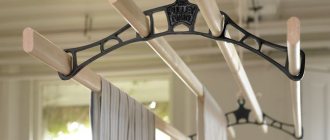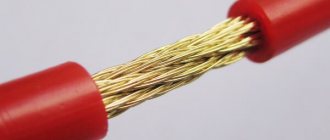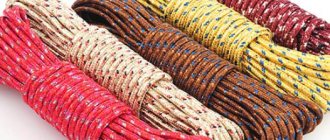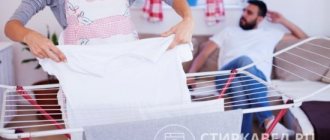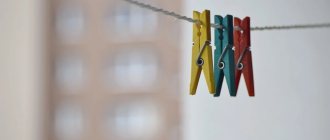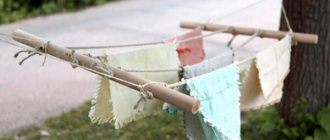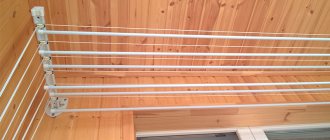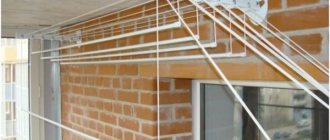Icer
34585 0 6
Icer September 12, 2016Specialization: master in the construction of plasterboard structures, finishing work and laying floor coverings. Installation of door and window units, finishing of facades, installation of electrical, plumbing and heating - I can give detailed advice on all types of work.
If washing machines take on all the worries about washing in modern conditions, then organizing the process of drying clothes still falls on the owners of the house, and if you have a balcony, then this is where you can install a special structure for these purposes. I will tell you about several options, consider all their pros and cons, so that you can make an informed choice. We will also consider options for homemade designs for those who like to make things with their own hands.
In the photo: modern manufacturers offer a lot of interesting and practical options for any balcony
Types of clotheslines
What is important when choosing ropes? Firstly, strength. They must be able to withstand the weight of wet laundry. Secondly, minimal stretching and sagging. You can choose from the following options:
- Metal cable sheathed in polyvinyl chloride. The most durable, long lasting product. It is not afraid of moisture, practically does not deform, and does not stain laundry. The disadvantage is the high price.
- Plastic cord. Moisture-resistant, does not stain clothes, comes in several colors, inexpensive. Disadvantage: soon after the start of use, it sag noticeably under the weight of the laundry.
- Polypropylene rope. Wear-resistant, difficult to deform. A good option at a good price.
- Jute cord. Durable, environmentally friendly, not electrified.
- Cotton rope. Durable, environmentally friendly, but moisture often causes dark spots to appear on it. They may leave marks on clothing.
Steel cable in PVC braid
Polypropylene laundry cord
Tip: Before choosing a more expensive option, evaluate your needs. Why do you need an expensive metal cable if you wash things in small parts?
Electric
A couple of decades ago, no one had heard of electric dryers, but today you can buy them in many stores. These designs consist of a bar with rays emanating from its center. The beams usually have different sizes, large ones are used for drying larger items, and small ones are used for smaller ones.
At the bottom of the electric dryer there is a device that supplies hot air. The cost of such models is higher than that of others; the main factor influencing it is the material. Typically electric dryers are:
- aluminum is the cheapest option, but it does not last long, since this substance quickly oxidizes, and rusty stains remain on clothes;
- made of stainless steel - a more expensive option, but at the same time more durable;
- steel ones are the most durable and reliable models, the only drawback of which is their high cost.
For those who are always in a hurry
Advice The most popular electric dryers are made of stainless steel, because they are more expensive than aluminum ones and have good strength. However, when purchasing, you must carefully study the instructions, since unscrupulous manufacturers may add an admixture of aluminum, so that over time the structure will begin to oxidize and become unusable.
How to pull ropes from the street side
The only way to string clotheslines at balcony level but beyond the parapet is to use metal brackets.
It is better to buy a prefabricated kit in a store. It consists of brackets, rope, rollers for moving it along with laundry, and fasteners.
It is easy to install such a device for drying clothes. Sequence of work:
- On the sides of the balcony parapet, mark the mounting locations for brackets with rollers.
- Make holes there.
- Secure the brackets with anchor bolts and wide washers.
- Stretch between the rollers and secure the clothesline so that it can be moved along with the clothes.
Instead of a ready-made kit, you can use scraps of steel pipes and metal corners. Just make holes in them for the rope.
Drying clothes outdoors is convenient. Under the sun's rays, laundry dries quickly. The balcony is not cluttered, the insolation of the adjacent room does not deteriorate. However, laundry may suffer from external influences. This is dust, bird feces, cigarette butts and debris from the upper floors, and other troubles.
Lianas
Linen vines look stylish and do not spoil the overall appearance of the balcony. In addition, in terms of strength and service life, such a dryer is several times better than simple ropes attached to slats. It belongs to the category of ceiling devices for drying things.
Lianas for linen
The vine is a frame equipped with cords and attached to a mechanism on rollers. One of the advantages of this model is that the length of each rope can be easily adjusted. Thanks to a special clamp, the rods can be easily fixed at the desired level.
Many note another advantage of the vine - it can be folded and in this position it takes up absolutely no space and does not attract attention to itself . The latest models are made so thinly that looking at them in assembled form, it is generally difficult to understand what it is.
long vine
Installation of the vine begins with the preparation of the fastening; it can be wooden beams or any other made of durable material. After this, you need to mark the place using a tape measure and a pencil. To install panels with rollers, you will need to drill into the previously installed fastening and drive a plug into it, and screw the panel on top.
After this, 1.5 m is measured from the floor and a bracket is attached, the ropes are alternately pulled through the panels with rollers. In this case, the short one is directed towards the fastening, and the long one clings to the roller opposite itself and descends along the fixed bracket. As a result, all ropes become the same length, stretched evenly.
How to secure ropes on a balcony
The method of drying clothes on the balcony, known for many decades, involves bent nails hammered onto a board, through which a rope is pulled. An alternative is special hooks. They look more aesthetically pleasing and more reliable.
Wall hooks for tightening rope
Another option is metal brackets with holes. This is truly something that will last for several generations, you just need to change the ropes in time.
This is not difficult to do, but it is better to use a whole piece rather than short pieces. Tie the rope into a knot not only at the beginning and end, but also at each of the fasteners (nails, hook). This will reduce its sagging under the weight of things and ensure greater reliability of the entire structure.
A knot for securely connecting two ends of a rope
Drying washed clothes on a glazed balcony protects them from bad weather, unpleasant odors, cigarette butts from neighbors above, and birds flying past. But this is also a occupied area, and it is inconvenient to move around the balcony. Therefore, you need to prioritize in advance between the ease of use of the room and drying clothes.
Aesthetics
Many people, especially women, worry that a dryer on the balcony can ruin their reputation in the eyes of guests and create a bad impression of the comfort in the apartment. If this moment worries you too, you can apply a few simple rules and tips. They will help organize the drying of things in such a way as not to spoil the overall appearance of the apartment.
Will not spoil the appearance of the balcony
As already mentioned, the practice of drying things on the street side of the balcony has long been outdated, and besides, such behavior is considered a sign of bad taste. Few people want their clothes, and especially their underwear, to be examined by strangers, while some, without hesitation, hang them out for everyone to see. Even if it is not possible to dry everything at once, you need to adapt to your circumstances and wash less, but more often.
In order to hide wet things from the eyes of guests, you need to take care of the presence of a curtain that would cover the window between the room and the balcony . It is desirable that it be dense and not see through. Some housewives find an original solution to this problem - they place a large climbing flower on the windowsill, which completely covers the entire glass, so that no one will guess that it is not just a houseplant, but also an important part of the interior.
Saving space on the balcony
It happens that it is not possible to close the curtain: if guests come during the day, then there must be daylight in the room. In this case, a simple rule that should always be followed when hanging clothes will be useful: intimate items, underwear should be located in the center, and everything else on the sides. Then sweaters, T-shirts and other large clothing will be a kind of barrier protecting intimate clothing from prying eyes.
The evolution of clotheslines – “Liana” dryer
There is a convenient, easy-to-install design on the household goods market - the Liana dryer. It consists of two functional units. One of them is attached to the wall, the other to the ceiling. A frame with rods on ropes is mounted on the ceiling. A holder for these cords is fixed on the wall. By moving them, you can raise and lower the clothes drying rods.
Wall-ceiling mount “Liana”
Note! The wall holder must be able to withstand the load of all the drying clothes, otherwise you simply will not be able to fix the rods in the desired position. The holder must be securely fastened.
The advantage of drying vines is the cascade arrangement of the rods. This allows clothes to dry quickly and evenly.
You can do the installation yourself. For this:
- Mark the location for attaching the brackets to the ceiling.
- Drill holes in these places using a hammer drill.
- Secure the brackets with self-tapping screws.
- In a position convenient for use, fix the cord holder on the wall with self-tapping screws.
- Take one barbell. Secure it in the structure by pulling a long cord through the left roller, and a long and short cord through the right one.
- Place height clamps (caps) on the ends of the cords.
Fastening element for installing a wall unit
The kit includes detailed installation instructions. Consider its provisions. After installation, check the operation of each rod.
Best models
A ceiling-mounted clothes dryer is a useful invention that is designed to make household work easier. In addition, it makes it possible to place wet laundry after washing in such a way that it does not create interference or take up much space. The question often arises, which ceiling clothes dryers are best. For these purposes, you need to familiarize yourself with this list.
Liana-lux 2m (5 rods)
This device is a design with rods that are adjusted with cords. The brackets are made of durable metal alloys, so they can withstand long periods of use. It is possible to immediately place items with a total weight of up to 2.5 kg on each rod.
The rods in this device are not made of plastic, but of light metal with anti-corrosion properties. They are round and wide, so they do not leave creases on the dried fabric, which often form during drying on a rope.
How to choose a clothes dryer
When choosing, pay attention to:
- Room area. The smaller the balcony, the less bulky the product should be. Mobile, sliding structures will help out.
- Interior Design. If your balcony is a comfortable room in a certain style, then the appearance of the dryer should correspond to it. You can find original stylized products on sale. For example, treated wooden beams suspended on chains.
- Quality of walls and ceilings. If there are significant defects, they may not withstand the weight of the structure with wet things. Do not choose wall-mounted models if the top of the end walls is made of plastic.
- Manufacturer. Well-known brands produce high-quality and safe products: Leifheit, Melicone, Gimi, Foppapedretti.
- Permissible load on ropes, rods, cables. Some of them can withstand only 5 kg, while others – all 30 kg.
- The material from which the dryer is made. It determines its durability, safety, and the absence of marks on drying clothes.
- Installation method: floor, wall, ceiling.
- Extension and folding of the structure.
Folding wall model
Installation method
Depending on the installation method, a clothes dryer on a balcony can be:
- ceiling;
- wall;
- floor;
- mounted
Various in type, mounting, volume and design
Yandex.RTB RA-1479455-2
The installation features of each model are clear from the names. Only clarification may be required regarding wall-mounted clothes dryers. They are usually small in size - 60-100 cm long, with 3-6 ropes/beams (pictured).
Wall-mounted clothes dryer for the balcony
Yandex.RTB RA-1479455-7
They are equipped with two or three large-diameter hooks, which allow you to hook the structure to horizontal partitions, for example, to a balcony railing. They can be placed indoors or outdoors, so the option is mobile and convenient. You just need to find a place for storage or make loops on the wall that you can hook onto a wall-mounted clothes dryer.
What are clothes dryers made of?
Clothes dryers are made of steel, plastic, aluminum, and rarely of wood. The same materials are used for rods and cables. Sometimes thick nylon threads or synthetic ropes are pulled instead.
Plastic structures are easy to maintain, fit into almost any modern interior, do not corrode, and are affordable. But with regular exposure to high temperatures or direct sunlight, they can become deformed. The strength indicator is low.
Plastic work unit housing
Aluminum dryers are fragile and prone to deformation. They can oxidize and leave stains on laundry. Among the advantages are low price and lightness.
Aluminum tube construction is not an option for every day
The most durable are stainless steel models. They can withstand a lot of weight and leave your laundry clean. The polymer coating is not afraid of moisture, which means it does not oxidize.
Please note! A polymer coating and a layer of paint are two different things. The paint quickly cracks and chips.
Wood products can be found rarely. Despite impregnations and upper protective layers, wood remains wood. It is sensitive to moisture, from which it becomes deformed and loses its attractiveness. However, if only the body (not the rods!) is made of wood, it will last for more than one year.
Floor structure with wooden frame Foppapedretti Stendipiu
Care instructions
To maximize the service life of the product, it is necessary to adhere to the operating requirements, not exceed the permissible loads and take care of the dryer. Maintenance rules depend on the material of construction.
For example, it is recommended to wipe plastic devices after each drying. In this case, you should not use products with an aggressive composition. Stainless steel products are the least demanding to maintain.
If the frame is powder coated, care must be taken to ensure that it does not crack. Otherwise, the resulting chips may accidentally damage the laundry. You should also periodically check the condition of the cords and replace them if necessary.
Additional functions - from lighting to disinfection
Modern clothes dryers provide additional functions for maximum convenient use.
- Backlight. It is located above the strings and is usually represented by bright LED lamps. They illuminate the workspace in the dark, making it easier to hang laundry.
- Wind drying. Built-in powerful fans blow air over wet clothes for a preset time.
- Disinfection with built-in ultraviolet lamp.
- Heating of rods with electric cable.
- Remote control. Using the remote control, you can set the operating time of individual mechanisms, lower and raise the laundry beams.
Multifunctional dryer model
“Smart” dryers are produced mainly by Japanese companies, for example, SensPa. Their Chinese colleagues are not lagging behind, presenting such worthy examples on the market as the Alcona models.
The price of automatic devices with the functionality discussed above ranges from 23-46 thousand rubles.
Much more affordable are standard options with a rod heating function. The price starts from 2.5 thousand rubles. They are easy to install and connect to the electrical network. Heating can be smoothly adjusted within the temperature range specified by the manufacturer. Electricity costs will increase slightly.
Electric dryer Sharndy
Counter figure eight (Flemish knot)
Counter eight
The knot originated in Europe about 800 years ago, was used in navigation to fasten the two ends of a cable or rope, and on land it was used to lengthen clotheslines.
The counter-eight knot is a very strong and reliable knot, it does not “creep” and does not greatly reduce the strength of the rope. Used for tying ropes of the same and different diameters, well suited for tying fishing line. Good to use for creating bulges on rope.
Disadvantages: knits slowly and tightens tightly (although not “tightly”).
Types of clothes drying devices
Depending on the working mechanism and method of fastening, there are several types of dryers. Each has its own advantages and disadvantages.
Sliding and folding models
If a private house has a spacious balcony where a stationary dryer can fit without any problems, there is no question about its working mechanism. The area of similar premises in typical high-rise buildings is modest. Therefore, when purchasing dryers, close attention is paid to their dimensions and folding capabilities.
Some of the most compact options are sliding ones. This can be a closed stationary block with strings that are wound inside on rollers. It is mounted on one wall, and the counter plate with hooks is mounted on the opposite wall.
When you need to dry clothes, the strings are pulled out in the manner of a construction tape and secured. Their tension can be adjusted manually (with a lever) or automatically.
Option with retractable strings
Advantages of sliding models:
- Compact.
- Thanks to the fastening to the walls, they do not take up useful floor space.
- They do not interfere with moving around the balcony when you are not drying clothes.
- Affordable.
Disadvantages: fragility of the plastic block, sagging strings, cannot withstand more than 8 kg of laundry.
Sliding products also include products with a stationary block and rods folded in the manner of an accordion bellows. To put them into working condition, they need to be pulled towards you. They are durable but short, making them suitable for small balconies and small families.
Top shelf and hooks provide additional storage and drying space for clothes
Folding models are floor-mounted, wall-mounted, and rarely ceiling-mounted. They usually take the form of guides with strings or rods. When not in use, they are compact - folded or simply fixed on the wall. If necessary, they are folded out or folded back.
Folding floor drying rack
Ceiling mounted
Mounting the dryer to the ceiling is convenient for small or complex balconies. If it is possible to adjust the height, when not in use they do not occupy any useful space and are almost invisible. The control can be automatic (remote control) or mechanical. In the second case, the dryer is equipped with a lever or a chain that performs its function, like on blinds.
Ceiling mounting option
All multifunctional models are attached to the ceiling for more efficient operation of fans and ultraviolet lamps.
Wall systems
Most sliding and folding drying racks are mounted to the walls. This is appropriate if the floor of the balcony is occupied by furniture or other objects. Assess the possibility of drilling into walls in advance. In old residential buildings they can crumble literally under your hands.
Wall-mounted clothes dryers are presented:
- Blocks with strings or ropes stretched between them.
- Blocks with retractable rods.
- Barbells with hangers.
- Folding, stationary nets on brackets.
- Brackets with fastenings for hangers.
- Platforms with hooks.
Compact tilt-up dryer
The greatest weight is supported by stationary structures on steel brackets.
Floor clothes dryers
Floor dryers are convenient for spacious balconies. Their advantages are as follows:
- Withstands heavy loads.
- Stable, safe.
- Allows efficient use of vertical space (products in the form of racks).
- They do not require fastening to the walls and, accordingly, damage to their finishing, or the use of special tools.
The lineup is impressive.
A variant familiar to many is a “clamshell” with strings. Its main part can be supplemented with folding or retractable side elements. Models with heated strings are usually made on the basis of these particular dryers.
For all its advantages, this design is unstable
Racks with horizontal or inclined “shelves”. For greater functionality and ease of use, manufacturers equip them with additional hooks, hangers, and wheels.
Multi-tiered design on wheels with hanger holders
Tall drying racks with a durable wooden frame, more reminiscent of a cabinet. Height can reach 180 cm.
Peter-Panni Foppapedretti for a large family
An original solution is a floor-standing electrical appliance with fans and a cover. The principle of its operation is simple: you hang out the laundry, cover it with a cover, and turn it on. The device operates from the mains. Hot air circulated by fans dries clothes many times faster than in natural conditions.
Simplified version of the drying cabinet
Three main maritime nodes
In fact, there are many “sea” knots, the types of which were needed and popular in the days of sailing ships, but have lost their relevance in our time. A fair portion of the connectives are no longer used, but there are three basic ones that are used almost always and everywhere. These are “gazebo”, “bleached” and “eight”.
The “arbor” knot, also known as the bowline, also known as the “king of knots”, does not tighten even under strong tension, is easy to knit, compact, does not slip, does not damage the cable, does not tighten itself and is easy to untie. This is a real king, possessing all the necessary positive qualities and having practically no shortcomings. This knot is used as a safety net when climbing to a height or going overboard, and is also suitable for connecting two ropes of the same or different diameters and materials.
The “bleeding” knot is very convenient for attaching a rope to smooth surfaces, for example, to a mast or yard. It refers to the type of knots whose types can be safely used without fear of problems with slipping or self-untying. It got its name due to the fact that for a long time they were used to attach castings (pieces of tarred cable used for climbing the masts) to the shrouds. This unit has a drawback - it is reliable only with constant tension. In maritime affairs it is used for fenders, tying boats to a pile.
“Eight” is a locking knot that underlies one and a half dozen more complex options. It is considered classic, and its big advantage is that even with strong traction it does not damage the rope and is easily untied. In everyday life, it serves as a good way to attach a rope handle to a bucket, to a children's sled, strings to the pegs of violins, mandolins, guitars, and the like.
In addition, types of maritime knots can be divided into auxiliary ones, connecting ropes to each other and securing the cable to the support.
DIY ideas for making a dryer
Those who like to craft from scrap materials can make a dryer themselves.
A hacksaw, an electric drill with a set of drills and wooden blanks provide a lot of possibilities. Example: a compact dryer that hinges from the wall and is secured with chains. The working part consists of only two side and several cross bars. The crossbars can be replaced with thick synthetic rope. Just make sure it is securely fastened.
The wood must be sanded and impregnated with an antiseptic composition
The ceiling version has a similar design.
The wood must be sanded and impregnated with an antiseptic composition
For a compact product you will need a minimum of materials
Take a look around, maybe your future dryer is nearby, and you haven’t even thought about it! Its function can be taken over by one of the sides of the crib or part of the “Swedish” wall.
A simple solution is to make a rod for drying clothes on hangers. The material can be metal pipes and fittings. Eco-style lovers can use a thick tree branch as a barbell.
Preparing for work
Of course, before stretching the clothesline on the balcony, it is advisable to carry out a series of preparatory works, namely, prepare the holding brackets and install them in a given place.
Moreover, if we talk in more detail about the first part of the work, then it is more justified to use rolled metal (angle, U-shaped profile, etc.) as brackets for securing the clothesline, although in some cases (with a light load) they can be used as such elements alternative materials can also be used, be it a wooden beam, a metal pipe, or a perforated lath.
As for the preparation of the elements holding the rope, it consists in simply drilling holes in the body of the material in increments of 120 - 200 mm. Moreover, taking into account the purpose of these holes (a rope is threaded through them), they should be located strictly symmetrically on both opposite brackets. If we talk about the diameter of the holes, then it should be larger than the size of the rope in order to ensure free insertion of the material.
In addition to making perforations for fixing the clothesline, at the preparation stage you should drill holes to directly attach the brackets to the fence structures. And of course, open the resulting paintwork structures for exterior work (rust will not stain the laundry).
The installation of holding profiles should be carried out in such a way that it is convenient to dry the laundry in the future. That is, based on individual factors (type of structure, physiological characteristics of the user, etc.), it is necessary to select the most suitable location and install the brackets. Moreover, if these structures are planned to be fixed to the wall, then it is advisable to use anchor bolts or dowels with screws (with a diameter of at least 6 mm). When the brackets are located on the outside of the balcony or loggia, it is more justified to fix the material using hardware (M8, M10), using at least two on each side.
Tags
make a knot with us self-tightening knot Self-tightening knot for making a knot for a rope the knot is tightened. Such a knot is called a self-tightening knot. You can such a knot without a Self-tightening knot make a knot on Knots for Using a knot connection Self-tightening knots for a variety of knots. tightening knot design Using a knot connection tightening knots helps self-tightening knot connections along the knot product. such a knot design
things tying article is window


